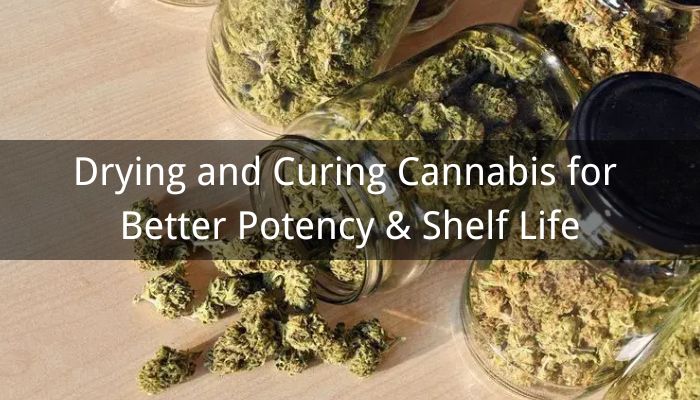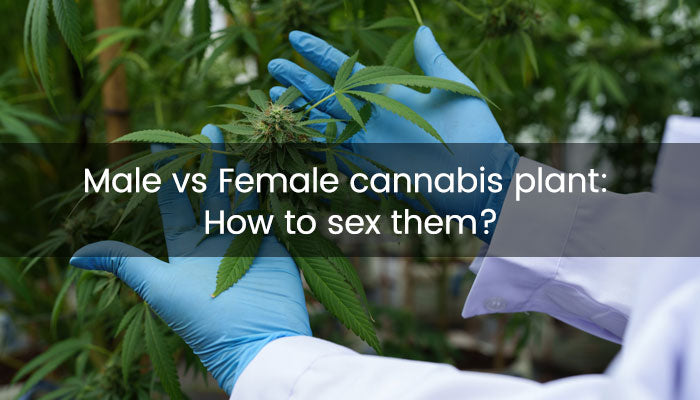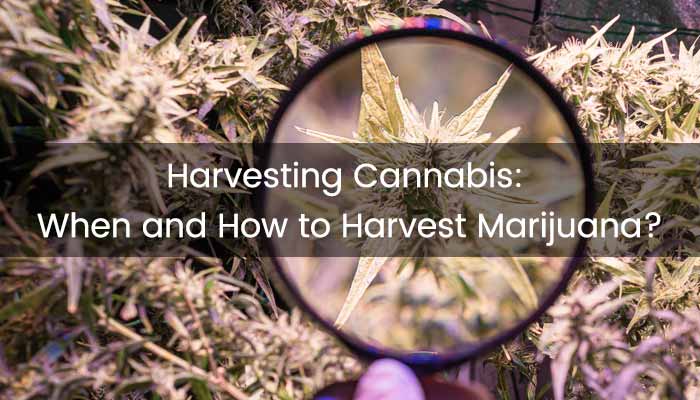When cannabis plants are harvested, the proper drying and curing process becomes a critical factor in determining their final quality, potency, and shelf life. These processes help preserve terpenes and cannabinoids while reducing the herbaceous odor and enhancing the unique flavors of cannabis.
In this article, we'll guide you through simple and effective methods for drying and curing cannabis and the time and environmental conditions required for drying. Whether you're a professional grower or a beginner, mastering these techniques can significantly improve the potency of your cannabis and ensure it retains its best flavor and aroma over time.
Why is Properly Drying and Curing Cannabis Important?
Properly drying and curing cannabis is not just about enhancing its aroma and flavor—it’s also essential for preserving its potency and ensuring long-term storage. Here are the key reasons why these steps are so important:
Preserving Terpenes and Cannabinoids
When drying and curing cannabis, maintaining the right temperature and humidity is critical to preserving its primary active compounds—terpenes and cannabinoids. Unfortunately, many growers rely on improvised methods, which can lead to terpene loss or even total crop failure, resulting in significant financial losses.
Reducing Harsh Grass-Like Smells
Freshly harvested cannabis often has a strong grassy odor. Proper drying and curing processes effectively reduce this unwanted smell, allowing the cannabis to develop more complex and pleasant aromas. This is especially vital for its commercial value in today’s highly competitive market.
Enhancing Cannabis Flavor and Quality
Curing balances the moisture content in cannabis, preventing issues like moldy weed caused by excess moisture. It also plays a crucial role in developing better flavors, quality, and color, enhancing the product’s market competitiveness and value.
Extending Shelf Life
Properly dried and cured cannabis has a significantly extended shelf life. Insufficient drying or incomplete curing leaves excess moisture, leading to spoilage, diminished potency, and turning multimillion-dollar harvests into subpar products. In contrast, well-cured cannabis maintains its high quality and potency over an extended period.
By ensuring proper drying and curing processes after harvest, cannabis growers can significantly enhance the overall quality of their products.
This not only preserves the optimal potency and flavor of the cannabis but also improves its market value. As a result, consumers enjoy a more satisfying experience, while growers benefit from increased product competitiveness and market demand.

How to Dry Cannabis
The purpose of drying cannabis is to remove moisture from the plant while preserving its terpenes and cannabinoids as much as possible, ensuring the final product’s quality, flavor, and potency. Below are the key steps for drying cannabis:
Step 1: Harvesting Cannabis
Ensuring the quality and flavor of the final cannabis product starts with the harvest. Timing is crucial when harvesting cannabis.
- Harvesting too early can result in lower potency.
- Harvesting too late may cause THC to degrade into CBN, reducing potency and potentially leading to a heavier, more sedative effect.
If you aim for higher THC levels, watch for these signs:
- Trichomes: When 70-90% of the trichomes turn milky white with a few amber ones, the THC level is at its peak, making it the ideal time to harvest.
- Pistil Color: Pistils are the hair-like structures on cannabis. When most pistils turn from white to reddish-brown, the plant is ready for harvest.
- Leaf Color: As the plant matures, many of its fan leaves begin to yellow. This is a normal sign that the plant is transferring its energy to the buds.
Besides THC content, harvest timing also affects flavor. Cannabis harvested in the early morning or late evening tends to have higher glucose levels, giving it a sweeter taste.
Pro Tip: Leave a "hook" on the plant when cutting it during harvest. This makes it easier to hang the plant directly on drying racks during the drying phase.
Additionally, inspect the plants during harvest for any signs of mold. Remove any moldy buds immediately to prevent the spread of contamination.
Step 2: Transferring to the Drying Space
A stable environment prevents cannabis from drying too quickly or too slowly, which helps preserve its quality. The following are requirements for a marijuana drying room.
Temperature and Humidity Control
- Temperature: Gradually lower to 55-60°F (13-15°C).
- Humidity: Maintain at 50-60%.
Air Circulation
Ensure adequate ventilation in the room, but avoid direct strong airflow to prevent damaging the buds or causing them to dry too quickly. Using fans with filters is recommended to keep dust from coming into contact with the cannabis.
Light Conditions
Keep the drying space dark, as light breaks down cannabinoids and reduces potency. Excessive light exposure can turn a multimillion-dollar harvest into a low-quality product.
Step 3: Trimming and Hanging Cannabis Plants
Trimming and hanging are two interdependent steps in the cannabis drying process, working together to ensure the best possible quality of the final product. Here are the different methods of trimming and hanging.
Dry Trimming
Leave the leaves intact until the drying process is complete. This slows down the drying speed and helps retain more terpenes.
Wet Trimming
Trim off most of the leaves immediately after harvest. This helps reduce drying time.

Hanging or Laying Out
Hang trimmed buds to dry or lay them flat on food-grade drying racks. Ensure there is enough space between them to prevent overcrowding and stacking.
- In humid regions: Separate the plant into individual branches or allow more space between plants to reduce the risk of mold.
- In dry regions: Consider drying the whole plant to slow down the drying process. A drying time of 7-14 days is ideal.

Step 4: Checking Progress
Inspect the buds daily to monitor their drying progress. A simple method is to bend the stems:
- If the stems snap easily, the drying process is complete.
- If the stems bend without breaking, more drying is needed.
For more precise measurements, use a hygrometer or moisture meter. Properly dried cannabis should have a moisture content of 8-12%.
Avoiding Common Issues
- Over-drying: High temperatures or excessive airflow can cause cannabis to dry too quickly, leading to terpene and cannabinoid loss, brittle buds, and diminished aroma.
- Under-drying: High humidity can lead to mold growth, compromising the quality and safety of the cannabis.
How Long Does It Take to Dry Cannabis?
Cannabis drying typically takes 7 to 14 days, depending on environmental conditions, bud size, and drying method. Larger buds may require more time, while smaller buds dry more quickly. Some growers prefer to extend the drying process to three weeks to preserve terpenes and flavor.
How to Cure Cannabis
Curing is a critical step after drying that helps further enhance cannabis potency, flavor, and shelf life. By gradually releasing the remaining moisture from the buds and breaking down residual chlorophyll and sugars, curing reduces the "green" taste and enhances the strain's flavor and aroma. Below is the specific method:
Prepare Curing Containers
The most commonly used containers are sealed glass jars as they maintain stable humidity and prevent excessive air exposure.
It is not recommended to use plastic bags or non-food-grade plastic containers, as they may release harmful chemicals and affect flavor.
Each jar should be filled 75-80%, leaving enough space for air circulation to help regulate humidity.

Environmental Requirements
- Temperature: Maintain between 18-22°C (65-72°F).
- Humidity: Keep humidity between 58-62%. Using humidity control packs (such as Boveda) can help stabilize the humidity.
- Light: Place the jars in a dark, cool location to prevent light from degrading cannabinoids and terpenes.
Curing Process
Open the jars daily (commonly known as "burping") for a few minutes to allow moisture to escape and fresh air to enter.
At the same time, check for any off smells or mold on the buds (if any odor is detected, remove the affected buds and adjust the humidity).
Once the humidity stabilizes and the buds feel softer to the touch, reduce the burping frequency to once or twice a week.
Curing Time
- Minimum Curing Time: 2 weeks—this will noticeably improve the buds' flavor and aroma.
- Optimal Curing Time: 4-8 weeks—during this time, the flavor, potency, and smoking experience will reach their peak.
Precautions
- Prevent Mold: If humidity is too high or burping is insufficient, mold can develop. Use humidity control packs or remove any damp buds to prevent this.
- Avoid Over-drying: Humidity below 55% can cause buds to become brittle, affecting flavor and potency.
Once the curing is complete, growers should store cannabis based on its quantity and intended storage duration. In the cannabis market, where supply far exceeds demand for CBD-derived products, long-term storage considerations are becoming increasingly important.
Top-shelf cannabis buds are best stored in food-grade, sealed 50-gallon plastic barrels. Additionally, cannabis should be stored in a climate-controlled indoor environment and should not be moved or disturbed frequently.
You might be interested in the following: Does weed expire?
Conclusion
By following the steps outlined above, you can not only enhance the potency of your cannabis but also enrich its flavor and provide a smoother smoking experience. Additionally, these methods will help extend its shelf life, preventing mold growth and quality loss.
Whether you're a beginner or an experienced grower, mastering these techniques ensures that your harvest reaches its highest quality and provides great satisfaction for future use and sharing.
If you're interested in growing, feel free to subscribe and bookmark our website. I will provide real-time updates on cannabis cultivation tips and exclusive offers on LED grow lights to help you achieve your growing goals.
FAQs about Drying Cannabis
1. What Is Day 1 of Drying Cannabis?
Day 1 of drying cannabis marks the start of the post-harvest process. On this day, harvested plants are trimmed and hung upside down or placed on drying racks. Ideal environmental conditions include: 65-72°F with a humidity level of 45-55%; Ensure gentle air movement; Keep a dark place.
2. Is 2 Weeks Too Long to Dry Cannabis?
A 2-week drying period for cannabis can be ideal under the right conditions, such as temperatures around 65-68°F and humidity levels of 55-60%, especially when whole-plant drying is used. This slower process helps preserve terpenes and cannabinoids.
3. How Do You Know if Buds Are Dry Enough?
To check if buds are dry enough, bend a small stem—it should snap rather than bend. The buds should feel dry on the outside but spongy when gently squeezed. A pleasant aroma indicates proper drying, while grassy smells suggest they need more time. Buds should also feel lighter than when fresh.




